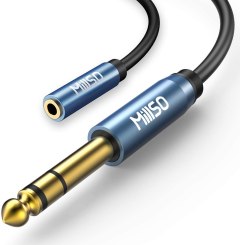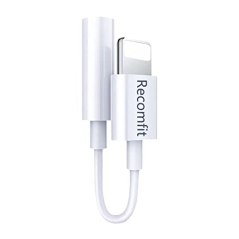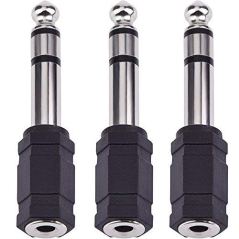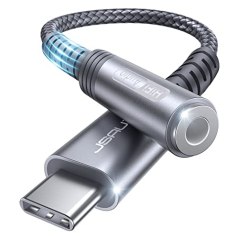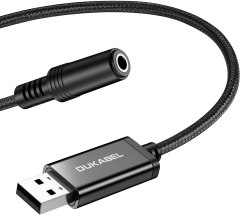Buying guide for best headphone jack adapters
Few things are more frustrating than buying new equipment, plugging it in, and finding out that it doesn’t work. With computers, mobile devices, and music players, this happens all too often, as modern technology uses a huge and often confusing array of input and output ports. Headphone jack adapters solve many of these issues because they get your devices to speak the same language and work together.
In a nutshell, headphone jack adapters allow you to connect your 3.5-millimeter headphone plug into myriad other ports, such as Lighting, instrument cable, USB-C, and others. They’re especially useful with devices that don’t include a headphone jack in lieu of wireless tech or an all-in-one Lighting port. In these cases, an adapter facilitates listening to music, browsing podcasts, and taking calls while the device charges.
Who needs a headphone jack adapter? Recording musicians, audiophiles, and anyone with only a single port to work with on their device. If that includes you, continue reading our buying guide and take a look at a few of our favorites.
Key considerations
Outport port
The primary concern when shopping for headphone jack adapters is simple: what do you need your 3.5-millimeter plug to go into? We’ve listed the most common examples below to get you started.
Lighting port: Proprietary connectors from Apple, Lighting ports allow you to network iPhones, iPads, and iPods with computers, monitors, chargers, and other peripherals. Lightning ports boast 30 pins for impressive performance. They can transmit both data and power, and they are very thin, which allows Apple to manufacture ever-thinner devices.
USB port: An industry-standard connector found on nearly every type of device, Universal Serial Bus ports facilitate data and power transfer between devices.
USB-C port: USB-C ports are smaller, newer, and faster versions of USB ports. They’re also considerably thinner than standard USB equivalents.
1/4-inch (6.35 mm) jack: These jacks are also known as instrument cables because they’re found on guitars, amplifiers, audio interfaces, and speakers. You’ll need a 3.5-millimeter-to-1/4-inch adapter to plug headphones into an amplifier or use the direct monitor port on recording hardware.
Splitters: Headphone splitters are simple: they turn a single 3.5-millimeter plug into two plugs. This allows you to connect two headsets or speakers to a single jack, giving more people the opportunity to listen from a single device.
Durability
Headphone cables and adapters get a lot of use. They’re plugged and unplugged, dragged across desks, dropped, and jumbled around in bags day after day. Cheap plastic models will bend and fray quickly, exposing the wires inside, and increasing the risk of failure. For extra peace of mind, look for braided cables, aluminum alloy housings, and reinforcement points where the cable naturally bends. All are positive signs of quality.
While the terms are often confused, “headphone plug” and “headphone jack” are not the same thing. Headphone plugs are the male connectors at the end of your headphone cable, and headphone jacks are the female connectors that you plug into.
STAFF
BestReviews
Features
Playback controls
Headphones that equip playback controls are incredibly convenient because you don’t have to dig through your pocket to adjust the volume, skip songs, or play or pause a song. If your favorite headset doesn’t have those controls, you can add them with select adapters! These products are a bit bulkier than other models, but the added utility might just make them worth it.
Two-in-one
Mobile devices with a single connection option, such as Apple iPhones with Lightning ports, are very thin and light. And while this is convenient for packaging and everyday use, you might run into issues if you want to replenish the battery while using non-wireless headphones. Two-in-one adapters have multiple ports to permit charging and listening at the same time.
High-resolution audio
For the highest-quality listening experience, look for headphone jack adapters that boast onboard amplifiers or digital-to-analog converter (DAC) chips. Not only do DACs produce high-fidelity sound, they often use less power so you can listen longer.
DID YOU KNOW?
MFi certification means your device has been officially rated to work with Apple products. If yours is certified, there will be a small authentication chip inside the Lightning connector, proving the product is authentic and safe to use.
STAFF
BestReviews
Headphone jack adapter prices
Inexpensive: For as little as $5, you can purchase a simple headphone jack adapter: 1/4-inch adapters are very common at this price point. They are often sold in packs, but you may find some 3.5-millimeter- to-USB-C adapters for around $10. These will be basic, though, usually plastic in construction and lacking in features.
Mid-range: Increase your budget to about $15 and you’ll enjoy adapters with metal housings, tough braided cables, and playback controls.
Expensive: At the top of the consumer range, you’ll spend $30 or more for two-in-one adapters that can charge and transmit audio through a Lighting port. In addition, you’ll find adapters with DAC chips or built-in amplifiers for crystal clear, high-fidelity sound.
Do you have a headset with a built-in mic but your device has separate jacks for audio input and output? In this case, you’ll need a headphone splitter adapter that separates your headphone and mic into two different cables.
STAFF
BestReviews
Tips
- Buy a spare adapter. These items are small, light, and very easy to misplace, but, fortunately, adapters often come in packs of two.
- Confirm that the adapter is compatible with your device. Not all adapters work with different operating systems, such as older versions of Apple iOS. Also, Lighting cables and USB-C cables can look very similar, but they are not interchangeable.
- Fasten the adapter to the headphone cable. Worried about misplacing your headphone jack adapter? Use a rubber band, zip tie, or hair tie to secure it tightly to your headphone cable, or use a hard case or bag to keep them together.
FAQ
Q. What do “mono” and “stereo” mean?
A. You’ll see these terms very often when researching audio equipment. They refer to the type of signal sent from your audio source to your headphones. “Mono” stands for monaural, and it uses a single audio channel. “Stereo” stands for stereophonic, and it uses two audio channels (left and right) to simulate natural human hearing. Stereo is often referred to as “surround sound,” but this is slightly misleading. True surround sound places sounds to the side and back of the listener for a truly immersive experience.
Q. What do I need in order to record music at home?
A. While you can technically use a headphone-style adapter to record instruments like an electric guitar, the reality is you won’t be happy with the results. Signals from electric guitars and non-powered microphones are very weak, which is why they’re commonly plugged into amplifiers for performances. USB audio interfaces boost the signal and translate the analog audio into digital audio so your computer can process it. With that in mind, you’ll want to start with a quality interface.
Other than your instrument, the interface, and the necessary cables, you’ll need a digital audio workstation (DAW), such as Abelton, Garageband, Audacity, Pro Tools, or others. These programs help you record, organize, edit, and master audio tracks into full songs, as well as offer clever “digital” instruments that you can play with your keyboard.
Q. My device doesn’t have Bluetooth. Is there an adapter to make it work with wireless headphones?
A. If you’re craving the convenience of wireless headphones but your device can’t support it, consider a Bluetooth transmitter and receiver. Much like a headphone jack adapter, these plug directly into your device’s headphone jack, but they transmit a powerful wireless signal instead of directly linking your headset and device. Simply pair the transmitter with the wireless headphones of your choice and enjoy the freedom of movement you’ve been wanting. Modern iterations offer low-latency, high-fidelity stereo sound for multiple devices at once.
Q. How can I make my headphones sound better?
A. If you’ve purchased a new pair of headphones but aren’t happy with the results, there are a few tricks that may improve their sound. First, confirm you’re using the relevant headphone sides (left/right) to your ears. If you’re using earbuds, this will be significantly more comfortable, and you’ll hear the audio mix as the engineers intended.
Also, change the ear tips if you’re using earbuds. Earbuds commonly come with a variety of tips, with each producing a different sound profile. Change them out until you find the bass, mid, and treble response to your liking.
If none of these tips work, try tweaking the equalization (EQ) settings on your device or your music-playing software. You’ll be surprised by how much you can tweak the sound just by turning a few (digital) knobs.


